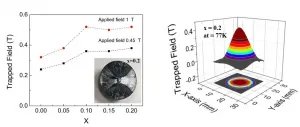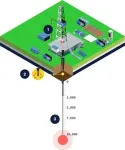INFORMATION:
-- Kelly April Tyrrell, kelly.tyrrell@wisc.edu, 608-262-9772
Vaccination, previous infection, protect against gamma variant in animal model
2021-06-18
(Press-News.org) MADISON - In early January 2021, travelers returning to Tokyo, Japan, from Amazonas, Brazil, were screened for COVID-19 at the airport. A few days later, the National Institute of Infectious Disease of Japan announced that the travelers had returned with a new variant of the SARS-CoV-2 virus.
That variant, known as gamma, or P.1, led to a deadly surge in COVID-19 cases in Brazil this spring, and has now spread across the world. More than 200 cases have been detected in Wisconsin. Whether current vaccines are as effective against the gamma variant remains unknown.
In a new study using variant virus recovered from one of the original travelers, researchers in the U.S. and Japan have found that vaccination with an mRNA vaccine induces antibody responses that would protect humans from infection with the gamma/P.1 variant. Hamsters previously infected with the virus strains first circulating in early 2020 were also protected from infection with the gamma variant nine months later.
The findings, the researchers say, suggest that previous SARS-CoV-2 infection and vaccines that are based on earlier strains of the virus still provide protection against infection with gamma. The study published in the Proceedings of the National Academy of Sciences on June 17, 2021.
"The animals were quite protected," says study lead Yoshihiro Kawaoka, a professor of virology at the University of Wisconsin-Madison School of Veterinary Medicine and the University of Tokyo. "There may be people who get infected with this variant even though they are vaccinated or were previously infected, but they shouldn't get severe disease."
However, he says, "that is not consistent with what has been happening in Brazil," where there have been reports of people reinfected with the gamma variant after recovering from infection with an earlier strain. It's possible, Kawaoka says, that COVID-19 immunity lasts longer in hamsters than in humans, or that cases documented as reinfections are actually first infections.
Kawaoka's research team established the Syrian hamster model for COVID-19 last year, after demonstrating that hamsters are highly susceptible to the SARS-CoV-2 virus and develop disease similar to humans, like ground glass opacity in their lungs. They also develop lasting antibodies that protect against reinfection.
"Animal models are great because (they allow us to) test vaccines, test drugs, test monoclonal antibodies and even do pathogenesis (studies)," says Kawaoka.
In fact, his team studied the gamma variant in hamsters because, while previous studies suggested P.1 might bind better to cells and resist antibodies created by previous infections or vaccination, little is known about the variant's ability to replicate in the body, how much illness or pathogenesis it causes, or how well immune responses react to the virus.
The researchers infected hamsters with either the P.1/gamma variant isolated from the traveler, or with one of two earlier strains of the virus from human samples -- one isolated from a patient in February 2020, and the other from a patient with a non-variant globally predominant strain. Each of the strains replicated similarly in the nose and lungs of hamsters and caused similar illness affecting the lungs.
Next, Kawaoka's team looked at whether antibodies in convalescent sera from 35 recovered COVID-19 patients or from people who'd received the Pfizer-BioNTech mRNA vaccine could neutralize each of the three viral strains.
Following a natural infection or vaccination, the body produces antibodies that learn to recognize the spike protein of the SARS-CoV-2 virus, which is responsible for binding to cells. Should people encounter the virus again, antibodies recognize the spike protein and subsequently fight off or limit the extent of infection.
Earlier studies have shown that a spike protein mutation -- E484K, found in gamma variants -- can change the spike protein's identity just enough that the variant can slip past these defenses. However, antibodies in the blood of vaccinated individuals reacted to all three strains, including gamma.
Antibodies in the blood of recovered COVID-19 patients were also effective at neutralizing each of the strains. However, of the 35 patients, one had been infected with gamma and the antibodies from this individual were less reactive to the non-variant strains.
The researchers say these findings suggest there are some important differences in the spike protein of gamma that might influence immunity, warranting further monitoring. Additionally, Kawaoka's group found that gamma, but not other strains of SARS-CoV-2, can infect and replicate in mice, suggesting that the spike protein interacts differently with cells than earlier strains.
The researchers also found that hamsters that had recovered from infection with either of the earlier strains of SARS-CoV-2 were protected against viral replication in their lungs if reinfected with either the same strain or the gamma variant, three weeks and nine months later.
However, gamma was recovered in the nasal passages of reinfected animals in both groups. The amount of virus in the nasal passages of reinfected animals was 1,000-fold lower than animals infected for the first time.
Finally, the researchers studied whether convalescent plasma from three patients infected with SARS-CoV-2 in early 2020 could protect against viral replication in the nose and lungs of hamsters. They found that convalescent plasma, but not plasma from patients who did not have COVID-19, limited virus replication in the lungs of hamsters infected with the prevailing non-variant strain and with gamma/P.1. Virus was found in their nasal passages.
Vaccination, Kawaoka says, is the best way to seek protection from SARS-CoV-2 and emerging variants, including the delta variant, also known as B.1.617.2. The Centers for Disease Control and Prevention recently designated the delta version as a variant of concern due to evidence that it transmits more readily.
Peter Halfmann, research associate professor at UW-Madison and co-leader of the study, added that the gamma and delta variants are circulating in Madison and other parts of the U.S., highlighting the importance of vaccination.
"The difference between the original strain and (delta) and the original strain and (gamma) is similar," Kawaoka adds, noting: "The (delta) variant may become prevalent but it shouldn't be extremely concerning as long as you are vaccinated."
With SARS-CoV-2 changing as it spreads, some versions of the virus will disappear as new variants emerge, as happened with a European variant in early 2020 that quickly eclipsed the original virus first found in China.
"At least in the vast majority of the population, we don't have good immunity to SARS-CoV-2, so the selective pressure on the virus at the moment is transmissibility," Kawaoka says, explaining why new variants that successfully spread tend to be more transmissible than those that came before. "But it will change. We should expect to see the selective pressure become immunity."
This is why vaccines will likely need to be modified in the coming years, he explains, in order to protect against a virus that will evolve to evade the protections we devise so long as spread of the virus remains high, or if our immune systems don't maintain defenses for long enough to prevent reinfections.
"We don't know which one is going to be the case ... it's too early to say how long immunity to this virus lasts," he says. "Hamsters look different from humans, anyway. It's difficult to predict."
Peter Halfmann, a research associate professor at UW-Madison, and Masaki Imai in the Division of Virology at the University of Tokyo, co-led the study.
It was supported by a Research Program on Emerging and Re-emerging Infectious Diseases (JP19fk0108113, JP19fk0108166, JP20fk0108412, and JP21fk0108104;, a Project Promoting Support for Drug Discovery (JP20nk0101612, JP20nk0101614, and JP20nk0101603); the Japan Initiative for Global Research Network on Infectious Diseases (J-GRID) (JP19fm0108006); the Japan Program for Infectious Diseases Research and Infrastructure (JP20wm0125002 and 20fk0108272) from the Japan Agency for Medical Research and Development (AMED); the National Institutes of Allergy and Infectious Diseases funded Center for Research on Influenza Pathogenesis (CRIP; HHSN272201400008C); the Wisconsin National Primate Research Center (P51?OD011106), and the Collaborative Influenza Vaccine Innovation Center (CIVIC; 75N93019C00051).
ELSE PRESS RELEASES FROM THIS DATE:
Managed retreat: A must in the war against climate change
2021-06-18
University of Delaware disaster researcher A.R. Siders said it's time to put all the options on the table when it comes to discussing climate change adaptation.
Managed retreat -- the purposeful movement of people, buildings and other assets from areas vulnerable to hazards -- has often been considered a last resort. But Siders said it can be a powerful tool for expanding the range of possible solutions to cope with rising sea levels, flooding and other climate change effects when used proactively or in combination with other measures.
Siders, a core faculty member in UD's Disaster Research Center, and Katharine J. Mach, associate professor at the University ...
KIYATEC clinical study data shows test accurately predicts brain cancer patient response
2021-06-17
KIYATEC, Inc. announced today the publication of new peer-reviewed data that establishes clinically meaningful prediction of patient-specific responses to standard of care therapy, prior to treatment, in newly diagnosed glioblastoma (GBM) and other high-grade glioma (HGG) patients. The results, the interim data analysis of the company's 3D-PREDICT clinical study, were published June 16, 2021 in Neuro-Oncology Advances, an open access clinical journal.
A goal of the study, which continues to enroll, was for the test's prospective, patient-specific response prediction to achieve statistical significance for ...
Study explores how the elderly use smart speaker technology
2021-06-17
Researchers from Bentley University, in partnership with Waltham Council on Aging in Massachusetts, and as part of a study funded by the National Science Foundation, have been exploring how the elderly use smart speakers at home. Waltham, a satellite city about eight miles west of Cambridge has a population of about 60,000, with about one in six being an elderly citizen. The purpose of the study was to understand how the elderly use the smart speaker technology at home. A smart speaker is a hardware device that is always-on. When a wake-word triggers the software contained in the device, the smart speaker listens to the command to provide a response or carry out the command (accessing resources ...
Women in science propose changes to discriminatory measures of scientific success
2021-06-17
When Ana K. Spalding, a Research Associate at the Smithsonian Tropical Research Institute (STRI) and Assistant Professor of Marine and Coastal Policy at Oregon State University (OSU) talks about mentorship in academia, she describes it as meaningful relationship. It goes beyond conversations about research and publications, and into shared experiences. This is just one approach--proposed by Spalding and 23 other women scientists from around the world, in a new article published in PLOS Biology--that calls for a shift in the value system of science to emphasize a more equal, diverse and inclusive academic culture.
The authors came together after reading a ...
On the road to practical, low-cost superconductors with unexplored materials
2021-06-17
Superconductors are something like a miracle in the modern world. Their unique property of zero resistance can revolutionize power transmission and transport (e.g., Maglev train). However, most of the conventional superconductors require cooling down to extremely low temperatures that can only be achieved with liquid helium, a rather expensive coolant. Material scientists are now investigating "high-temperature superconductors" (HTSs) that can be cooled to a superconducting state by using the significantly cheaper liquid nitrogen (which has a remarkably higher temperature than liquid helium). ...
Changing a 2D material's symmetry can unlock its promise
2021-06-17
TROY, N.Y. -- Optoelectronic materials that are capable of converting the energy of light into electricity, and electricity into light, have promising applications as light-emitting, energy-harvesting, and sensing technologies. However, devices made of these materials are often plagued by inefficiency, losing significant useful energy as heat. To break the current limits of efficiency, new principles of light-electricity conversion are needed.
For instance, many materials that exhibit efficient optoelectronic properties are constrained by inversion symmetry, a physical property that limits engineers' control of electrons in the material and their options for designing novel or efficient devices. In research published today in Nature ...
Sorghum, a close relative of corn, tested for disease resistance on Pennsylvania farms
2021-06-17
With sorghum poised to become an important crop grown by Pennsylvania farmers, Penn State researchers, in a new study, tested more than 150 germplasm lines of the plant for resistance to a fungus likely to hamper its production.
Sorghum, a close relative to corn, is valuable for yielding human food, animal feed and biofuels. Perhaps its most notable attribute is that the grain it produces is gluten free. Drought resistant and needing a smaller amount of nutrients than corn to thrive, sorghum seems to be a crop that would do well in the Keystone State's ...
Most comprehensive RNA-Atlas ever
2021-06-17
The article 'The RNA Atlas expands the catalog of human non-coding RNAs', published today in Nature Biotechnology, is the result of more than five years of hard work to further unravel the complexity of the human transcriptome. Never before such a comprehensive effort was undertaken to characterize all RNA-molecules in human cells and tissues.
RNAs in all shapes and sizes
Our transcriptome is - analogous to our genome - the sum of all RNA molecules that are transcribed from the DNA strands that make up our genome. However, there's no 1-on-1 relationship with the latter. Firstly, each cell and tissue hasve a unique transcriptomes, with varying RNA production and compositions, including tissue-specific RNAs. Secondly, ...
Researchers propose methods for additive manufacturing quality control
2021-06-17
Additive manufacturing offers an unprecedented level of design flexibility and expanded functionality, but the quality and process can drastically differ across production machines, according to Hui Yang, a professor of industrial engineering at Penn State. With applications in aerospace, health care and automotive industries with potential for mass customization, additive manufacturing needs quality management.
To address this concern, Yang and a team of researchers from Penn State, University of Nebraska--Lincoln and the National Institute of Standards and Technology (NIST) proposed the design, development and implementation of a new data-driven methodology for quality control in additive manufacturing. They published their work in the Proceedings ...
Quaise Inc. drilling technology could allow geothermal to power the world
2021-06-17
CAMBRIDGE, MA--Geothermal energy systems have the potential to power the world and become the leading technology for reducing greenhouse gas emissions if we can drill down far enough into the Earth to access the conditions necessary for economic viability and release the heat beneath our feet. END ...



